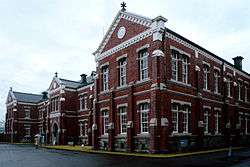National Museum of Modern Art, Tokyo
.jpg)

The Tokyo National Museum of Modern Art (東京国立近代美術館 Tōkyō Kokuritsu Kindai Bijutsukan) in Tokyo, Japan, is the foremost museum collecting and exhibiting modern Japanese art.[1]
This Tokyo museum is also known by the English acronym MOMAT (National Museum of Modern Art, Tokyo). The museum is known for its collection of 20th-century art and includes Western-style and Nihonga artists.
History
The National Museum of Modern Art, Tokyo, was the first National Museum of Art in Japan and dates back to 1952, when it was established as an institution governed by the Ministry of Education. The architect of the building was Kunio Maekawa. On two later occasions, neighbouring premises were purchased and the Museum was further enlarged. The most recent re-design of MOMAT was conceived by Yoshiro Taniguchi (father of Yoshio Taniguchi who designed the extension of MOMA in New York).
Collections
The collection contains many notable Japanese artists since the Meiji period as well as a few contemporary Western prints.
In the early years of the 20th century, Matsukata Kojiro collected Japanese ukiyo-e woodblock prints which had been scattered throughout the world. The 1925 exhibition of the woodblock prints Mtsukata collected abroad is thought to have been the first of its kind in Japan.[2] Today approximately 8,000 ukiyo-e prints from the Matsukata collection are housed in the Tokyo National Museum.[3]
Crafts Gallery
In 1977, the museum opened an annex, the Kōgeikan Crafts Gallery, that collects and exhibits textiles, ceramics, lacquer, and other Japanese crafts as well as craft and design from around the world dating from the late 19th century to the present. Its collection focus in particular is the work of Japanese Living National Treasures. The Crafts Gallery maintains its own research library.
National Film Center
The Kyōbashi building, remodeled after the move to Kitanomaru Park, now houses the museum's National Film Center (NFC). The nation's only public institution devoted to cinema, it holds about 40,000 films, and numerous other materials, in its collection. The Center has film-related materials on permanent display; and it holds special screenings in its theaters. NFC is a member of The International Federation of Film Archives. It preserves many important works of Japanese and world film history, including films designated as Important Cultural Properties of Japan like Momijigari.[4]

NFC recently restored a Japanese animated film which had been first released in 1917—the oldest existing example of a Japanese animated film originally made for the cinema. The film, "The Blunt Samurai Sword" (Namakura-gatana) is the first work of Junichi Kouchi, one of the founders of Japanese animated film.[5] A rare surviving print was unexpectedly discovered in an antique market in Osaka. In the silent comedy, the animation tells the story of a samurai warrior who is tricked into buying a dull-edged sword. He tries to attack passers-by in an effort to test the sword's quality, but lower-class townspeople fight back and knock him down.[6] The animated story lasts just two minutes. Although the ultimate status of the film remains uncertain, it was screened by NFC for the public in late April 2008. With the involvement of the NFC, the animated film became something more than an historical artefact—it also became an illustration of the progress film restoration has made over recent decades.[5]
The NFC's Tokyo headquarters in the Kyōbashi building is a one-minute walk from Kyōbashi Station (Station G-10) on the Tokyo Metro Ginza Line. It is also a one-minute walk from Takarachō Station (Station A-12) on the Toei Asakusa Line. An NFC branch is located in the city of Sagamihara in neighboring Kanagawa Prefecture.
Union catalog
The "Union Catalog of the Collections of the National Art Museums, Japan" is a consolidated catalog of material held by the four Japanese national art museums—the National Museum of Modern Art in Kyoto (MOMAK)), the National Museum of Modern Art in Tokyo (MOMAT), the National Museum of Art in Osaka (NMAO), and the National Museum of Western Art in Tokyo (NMWA):[7]
- National Museum of Modern Art, Kyoto (MOMAK).[8]
- National Museum of Modern Art, Tokyo (MOMAT)
- National Museum of Art, Osaka (NMAO)
- National Museum of Western Art (NMWA)
The online version of this union catalog is currently under construction, with only selected works available at this time.[7]
Selected artists
- This is a dynamic list and may never be able to satisfy particular standards for completeness. You can help by expanding it with reliably sourced entries.
|
|
Notes
- ↑ Nussbaum, Louis-Frédéric. (2005). "Museums" in Japan Encyclopedia, pp. 671-673.
- ↑ Checkland, Olive. (2002). Japan and Britain After 1859: Creating Cultural Bridges, p. 107.
- ↑ NMWA collection
- ↑ "Hakkutsu sareta eigatachi 2009" (in Japanese). National Film Center, National Museum of Modern Art, Tokyo. Retrieved 10 December 2014.
- 1 2 "Old anime discovered, restored," Daily Yomiuri Online. March 28, 2008.
- ↑ "Japan’s oldest animation films," ImprintTALK. March 31, 2008.
- 1 2 IAI-National Museums of Art union catalog
- ↑ MOMAK union catalog
See also
- List of Independent Administrative Institutions (Japan)
- Visage Painting and the Human Face in 20th Century Art
| Wikimedia Commons has media related to National Museum of Modern Art, Tokyo. |
| Wikimedia Commons has media related to Crafts Gallery, The National Museum of Modern Art, Tokyo. |
References
- Checkland, Olive. (2002). Japan and Britain After 1859: Creating Cultural Bridges. London: Routledge. ISBN 0-7007-1747-1
- Falk, Ray. "French Art in Tokyo," New York Times. June 21, 1959.
External links
- da Silva, Joaquín (29 April 2016). "Chronology of Japanese Cinema: 1900". EigaNove.
- National Museum of Modern Art, Tokyo (in English)
- Artfacts.net: MOMAT overview
- Independent Administrative Institution National Museum of Art (in Japanese)
- Show of Leiko Ikemura in the National Museum of Modern Art, Tokyo 2012
Coordinates: 35°41′26″N 139°45′17″E / 35.690508°N 139.754652°E